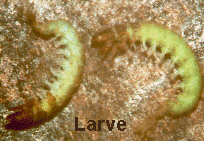
This is only an overview of the caddis and not a complete work. The goal of this work is for you to familiarize yourself with this specie and maybe to drive you to follow up and study it a bit more.
You will find here one the main food supply of trout. For this essay we will call them "caddis"
Caddises, like I mentionned in the Mayflies, paper have a complete progressive metamorphosis
of 4 stages: the egg, the larva, the pupae and the adult.
Contrary to the Mayfly, the caddis mates on the ground or the vegetation near rivers or streams. Following the mating stage, the female adult skips over the water and sometimes literally runs on the water's surface to deposit her eggs.
The eggs sinks to the bottom of the river bed, hatches in larvas and then builds a protective casing around itselves in a cocoon like manner. They re-build there cages around 5 times during the time they grow into a pupae.
3 weeks before the hatch, tha larva seals the entrance of the cage and starts it's metamorphisis into a pupae. When complete, the pupae breaks open the sealed door and swims to the surface to become an adult caddis. You will see sometime some "skins" of the pupae floating on the surface.
Contrary to the mayfly, the adult lives between two weeks to three months. Most caddises have two generations a year but the larger species have only one generation.
THE LARVAE



The larva has an appearance of an algromite and hides inside it's casing. The casing is usually made of small twigs, stones and other debris that comes down the stream. The form of the casing will give you and idea of the specy that resides inside.
Inside the casing the larva develops into a pupae that looks greatly like the aduld caddis but with shorter wings. It has long legs and antennas and an abodomen well developed. The abdomen has 8 sections, a row of gills on the side. On many large species the abdomen is larger than the thorax.
The adult ressembles the pupae but with larger wings, somme species have transparent wings.
SIZE:
Some larger adult might reach 30mm (1 1/2") and the smaller one 6-7 mm (1/2").
The pupae is normaly the same size as the adult.
COLOUR
The larva has a dark head with green or tan abdomen. The pupae have a green to brown tint with all the variants included.
The adult has a green body with brown or grey wings. Some species have transparent wings with a red/brown or beige in colour.
HABITAT:
The caddises can support all kinds of water but they prefer shallow, clean and well oxigenated waters. Most feed on algue and animal particles. They find this food in weed beds. The trout feeds mostly on the pupae and adult. The larva is rarely eaten by he trout has it seldom comes out of it's casing.
FISHING
The adult caddises are eaten by the trout when they surface to hatch and dry their wings or when they return to the stream to deposit their eggs. Presenting the immitation will defer in each of these cases. When they hatch, a still presentation without any movement is required and when they deposit their eggs a skidding movement will be needed.
When the female deposits her eggs, you will notice that she skips over the water and sometimes run on the surface, then you do the same as the natural does. In both cases you will find that a calm windless day is much better to fish these imitations.
The first hatche occurs around the end of may and will grow until the middle of july. After that period they will decrease until mid-september. This is only a guide as temparature will dictate much of the hatch activity. Many hatches happens at the end of the after-noon and some at dusk.
Hoping that this will be of help to identify this specie that served me well during my years of fishing.
Tight Lines
Michel Lajoie

| 
